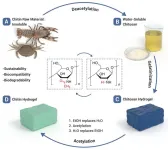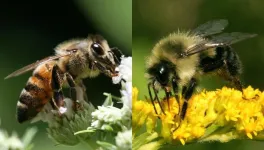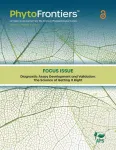Chitin hydrogel is recognized as a promising material for a variety of biomedical applications. Its biocompatibility and biodegradability make it useful in tissue repair, artificial organs, and wound healing. Yet scientists continue to face challenges in fabricating chitin hydrogel. A team of researchers has developed a green, efficient and scalable preparation method for chitin hydrogels.
The team’s work provides a rational strategy to fabricate chitin hydrogels and paves the way for its practical applications as a superior biomedical material.
Their findings are published in the journal Nano Research on July 01.
Chitin, the second most abundant natural polymer, is a substance that comes from the exoskeletons of crabs, prawns, and insects. Chitin is renewable, degradable, biocompatible and low-cost. These qualities make it an excellent candidate for various biomedical uses. “Chitin hydrogel, which shares many similarities with extracellular matrix, is an ideal material for tissue engineering and regenerative medicine. However, it is a challenge to dissolve chitin in aqueous solutions to produce hydrogel materials. Therefore, it is of great significance to develop rational fabrication strategy,” said Li-Bo Mao, a professor at the University of Science and Technology of China.
To be useful in biomedical applications, the chitin hydrogel must be biologically safe and have the appropriate mechanical strength and chemical stability. It must resist biofouling, which could lead to inflammatory response or immune rejection in the human body. For commercial use, the chitin hydrogel must also be low-cost and scalable.
The challenges in fabricating strong chitin hydrogel arise because of the insolubility of chitin in many solvents and the reduced chain length of chitin regenerated from solutions. Biopolymer hydrogels are typically prepared with a two-step process: the dissolution of the biopolymer and the subsequent gelation. However, chitin is not soluble in water or other common solvents because of the numerous inter- and intra-molecular hydrogen bonds between the polymer chains. The team tackled this challenge by fabricating chitin hydrogel with biomimetic structure through the chemical transformation of chitosan, a water-soluble deacetylated derivative of chitin.
Chitosan is easily dissolved in water in the presence of acids. These chitosan hydrogels can be endowed with different microstructures. However, they are not mechanically or chemically stable. Attempts to improve them by using crosslinking agents have raised biosafety concerns.
The team was successful in fabricating a chemically stable and antifouling chitin hydrogel via a chemical reaction called acetylation. Through the acetylation process, the chitin hydrogel the team obtained possesses outstanding resistance to swelling, degradation, extreme temperature and pH conditions, and organic solvents.
The team also learned that by templating the chitosan precursor with ice crystals, they could produce chitin hydrogels with different biomimetic structures. These structures can be either nacre-like or wood-like depending on the freezing method used with the chitosan precursor.
The chitin hydrogel developed by the team has excellent mechanical properties while retaining a high water content. It also shows excellent antifouling performance, resisting the adhesion of proteins, bacteria, blood, and cells.
“Besides the many advantages that are characteristic to chitin, the hydrogel materials we obtained are mechanically strong and robust. In addition, the hydrogels can be feasibly processed into different shapes and structures. These ensure the practical applications of the chitin hydrogels,” said Mao.
Looking ahead, the team’s next step is to further improve the mechanical properties of chitin hydrogels and explore their biomedical applications via in vivo experiments. “We anticipate various chitin-based hydrogel materials can be fabricated through this strategy and used for different clinical applications, such as cartilage replacement, bone replacement, wound dressing and even artificial organs,” said Mao.
The research team includes Rui-Rui Liu, Yu-Feng Meng, Li-Bo Mao, and Shu-Hong Yu from the University of Science and Technology of China; and Qian-Qian Shi and Yong Zhou from the Anhui Province Medical University.
The research is funded by the National Key Research and Development Program of China, National Natural Science Foundation of China, and the Key Scientific Research Foundation of the Education Department of Anhui Province.
##
About Nano Research
Nano Research is a peer-reviewed, international and interdisciplinary research journal, publishes all aspects of nano science and technology, featured in rapid review and fast publishing, sponsored by Tsinghua University and the Chinese Chemical Society. It offers readers an attractive mix of authoritative and comprehensive reviews and original cutting-edge research papers. After 15 years of development, it has become one of the most influential academic journals in the nano field. In 2023 InCites Journal Citation Reports, Nano Research has an Impact Factor of 9.9, the total cites reached 35645, ranking first in China's international academic journals, and the number of highly cited papers reached 194, ranked among the top 1.8% of 8769 academic journals.
About Tsinghua University Press
Established in 1980, belonging to Tsinghua University, Tsinghua University Press (TUP) is a leading comprehensive higher education and professional publisher in China. Committed to building a top-level global cultural brand, after 41 years of development, TUP has established an outstanding managerial system and enterprise structure, and delivered multimedia and multi-dimensional publications covering books, audio, video, electronic products, journals and digital publications. In addition, TUP actively carries out its strategic transformation from educational publishing to content development and service for teaching & learning and was named First-class National Publisher for achieving remarkable results.
END



